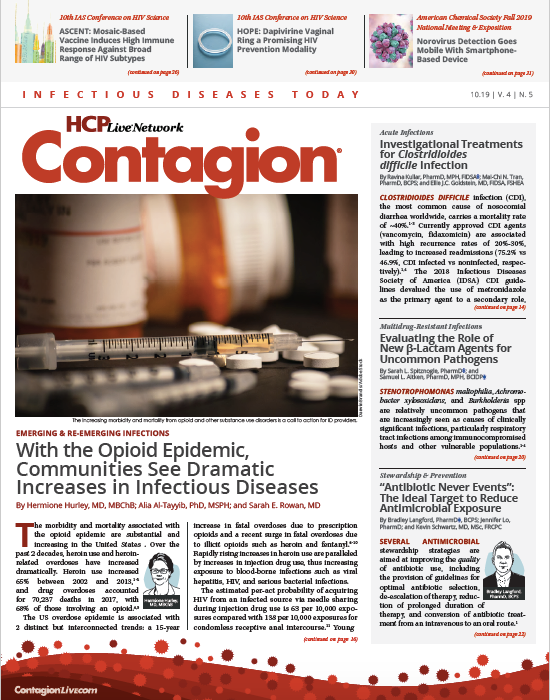Antibiotic Resistance: Patients Don't Get It, and We Need to Help
In the October Editor-in-Chief letter, Dr. Jason Gallagher writes about the role clinicians play in helping patients understand antibiotic resistance.
Something caught my eye on Twitter the other day. Someone had tweeted a study whose results showed that 72% of respondents to a survey in South Africa believed that antibi­otic resistance is due to the human body’s increasing resistance to antibiotics, not the bacteria that actually cause infection.1 It is a shocking number, so I did some digging around to see whether it was an outlier. Was it? Not even close. The World Health Organization performed a study across 12 countries to examine public perceptions on antibiotic resistance and use and found that 76% of respondents thought the same thing.2 Although differences among countries were noted, more than half of those surveyed held this belief. Results from some studies have shown this conviction is even more common. The belief that antibiotics can treat viral infections is also persistently shown at >50% across studies.3-5
This is not good news. However, should it really be surprising? Without an understanding of microbiology, why would we expect patients to understand what antibiotics actually do and how bacteria evolve to be resistant to them? The observation that a course of azithro­mycin that seemed to work previously but failed a second time does seem like the body has become resistant to the effects of the drug. It also parallels patient experiences with other medications. After all, how much education about medical microbiology do most people receive in school?
Beyond these easily disproved notions, we shoulder a lot of blame for people misunder­standing antibiotic resistance. When I think of the many times that I have heard clinicians say that they are giving a patient a “powerful antibiotic” with the intention of bolstering patient confidence in the choice, it leaves me wondering what a patient has learned from the experience. How about when people say that a patient has a particular “bug” being treated with an antibiotic? Psychologically projecting those potential misunderstandings creates some creepy possibilities. Many clinicians and patients alike believe that the mantra to “take all your antibiotics, even if you feel better” is to prevent antibiotic resistance, although the evidence to support this for acute infections does not exist. With increasing evidence supporting shorter courses of antibiotics, many “nonadherent” patients who stop antibiotics before finishing the recommended full course may ironically be choosing the right path, albeit inadvertently.
Addressing these misconceptions is important. Many of the pressures that lead to increasing antibiotic resistance are psychological. Although practitioners often report in surveys that they feel compelled to prescribe antibiotics to satisfy patients, this fear may be overblown. Ambulatory “toolkits” for respiratory viral infections that explain basic microbiology and the futility of antibiotic use for these infections and that contain directions for treating symptoms and escalating care when necessary have been shown to decrease antibiotic use with high degrees of patient satisfaction. Explaining antibiotic resistance itself may be difficult, but even brief descriptions of what it is can help. We should adjust our language, as well, because terms that are convenient for us can be misleading. Something as simple as replacing bug with bacteria in our jargon and antibiotic-resistant bacteria instead of antibi­otic resistance is a simple yet informative step. Let’s make these easy switches, discard the term powerful antibiotic, and take a little time to educate during each patient encounter to help preserve anti-infectives.
Our feature article this month—by Hermione Hurley, MD, MBChB; Alia Al-Tayyib, PhD, MSPH; and Sarah E. Rowan, MD—explores the dramatic increases in infectious diseases in the wake of the opioid epidemic.
As always, enjoy this issue, and keep up with us at ContagionLive.com.
Gallagher is a clinical professor at Temple University School of Pharmacy and clinical pharmacy specialist in infectious diseases at Temple University Hospital, both in Philadelphia, Pennsylvania. He is also the director of the PGY2 Residency in Infectious Diseases Pharmacy at Temple. *He is an active member of the Society for Infectious Diseases Pharmacists.
References:
- Farley E, Van den Bergh D, Coetzee R, Stewart A, Boyles T. Knowledge, attitudes and perceptions of antibiotic use and resistance among patients in South Africa: A cross-sectional study. S Afr Med J. 2018 Aug 28;108(9):763-77 doi: 10.7196/SAMJ.2018.v108i9.12933.
- World Health Organization. Antibiotic resistance: Multi-country public awareness survey. WHO.int. Published November 2015. Accessed August 1, 2019.
- Davis ME, Liu TL, Taylor YJ, et al. Exploring Patient Awareness and Perceptions of the Appropriate Use of Antibiotics: A Mixed-Methods Study. Antibiotics (Basel). 2017 Oct 31;6(4). pii: E2 doi: 10.3390/antibiotics6040023.
- McCullough AR, Parekh S, Rathbone J, Del Mar CB, Hoffmann TC. A systematic review of the public’s knowledge and beliefs about antibiotic resistance. J Antimicrob Chemother. 2016 Jan;71(1):27-33. doi: 10.1093/jac/dkv310. Epub 2015 Oct 12.
- Schmidt ML, Spencer MD, Davidson LE. Patient, Provider, and Practice Characteristics Associated with Inappropriate Antimicrobial Prescribing in Ambulatory Practices. Infect Control Hosp Epidemiol. 2018 Mar;39(3):307-31 doi: 10.1017/ice.2017.263. Epub 2018 Jan 30.

